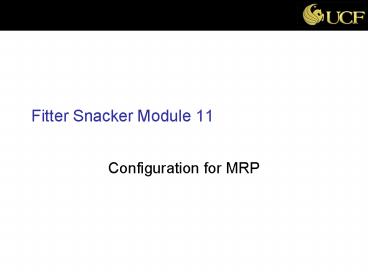Fitter Snacker Module 11 - PowerPoint PPT Presentation
1 / 19
Title: Fitter Snacker Module 11
1
Fitter Snacker Module 11
- Configuration for MRP
2
Fitter Snacker Configuration
3
Semi-finished Materials
- Dough is a semi-finished material
NRG-A Finished Snack Bars
Dough NRG-A Semi-finished
Raw Materials
4
Semi-finished Materials
- Finished Materials NRG-A and NRG-B
- Snack bars, which are manufactured in-house and
sold - Semi-finished Materials Dough NRG-A and
Dough NRG-B - Dough, which is mixed from raw materials and used
to make snack bars - Neither purchased nor sold
- Raw materials Oats, Wheat Germ, etc.
- Materials which are purchased and used to make
the semi-finished dough
5
Production Master Data
Capacity planning and product costing are not
considered in this course
All four types of production master data are
required to execute production planning and
scheduling
6
Bill of Material (BOM)
- BOMs are represented as single-level
relationships between a material and its
components and sub-assemblies
BOM for NRG-A
BOM for Dough NRG-A
7
Bill of Material (BOM)
- BOMs are represented as single-level
relationships between a parent material and
its components and sub-assemblies, known as
children. - In SAP, the BOM is referred to by the parent
component. - Complicated BOMs are built up level-by-level
8
Bill of Material (BOM)
- Both the quantity and unit of measure for the
parent component and the quantity and unit of
measure for the child component must be entered
when creating the BOM - Combined with the ability to define alternate
units of measure, this method of defining the BOM
provides a high degree of flexibility
9
Bill of Material (BOM)
- The quantity and unit of measure for the parent
component are entered in the header of the BOM as
the base quantity7 cases in this example.
10
Bill of Material (BOM)
- The quantity and unit of measure for child
components are entered in the item overview of
the BOM500 lb. of dough in this example.
11
Bill of Material (BOM)
- In the BOM for Dough, there are a number of child
components
12
Work Centers and Storage Locations for Fitter
Snacker
- Raw Materials are stored in storage location 100
- Semi-finished materials are produced on the
Mixers workcenter and stored in storage location
200 - Finished materials are produced on the Bakeline
workcenter and stored in storage location 300
13
Work Centers and Storage Locations for Fitter
Snacker
14
Workcenters
- Production is carried out at workcenters.
- In the SAP R/3 system, workcenters could
represent machines or groups of machines,
production lines, assembly lines, employees or
groups of employees. - Workcenters have capacities defined and assigned
that can be used for planning to make sure the
there is sufficient capacity available for the
production orders that are released.
15
Routings
- Routings specify the workcenters a material must
be routed through to be produced - It also specifies the capacity needed to process
a production order
Capacity Required
Workcenter Visited
16
Capacity
- Workcenters define the available capacity in the
production facility - Routings define the capacity required by a
particular production order - Capacity planning involves scheduling production
orders so that the capacity required by
production orders does not exceed the capacity
available at workcenters
17
Material Assignment
- The routing also determines at which operations
material that is needed in production can be
issued. - The material required is determined from the BOM.
- The routing defines when it can be used.
18
Material Assignment
Assigned via BOM All materials assigned to
first operation
Material
Material
Material
Assigned via Routing Materials can be
assigned to specific operations
Material
Material
Material
19
Material Assignment
Materials a selected in the Material Component
Overview Screen, then assigned to an operation
number in the routing. Operations are numbered
10, 20, 30, etc. by SAP to allow new operations
to be inserted in a routing without having to
renumber all operations.































